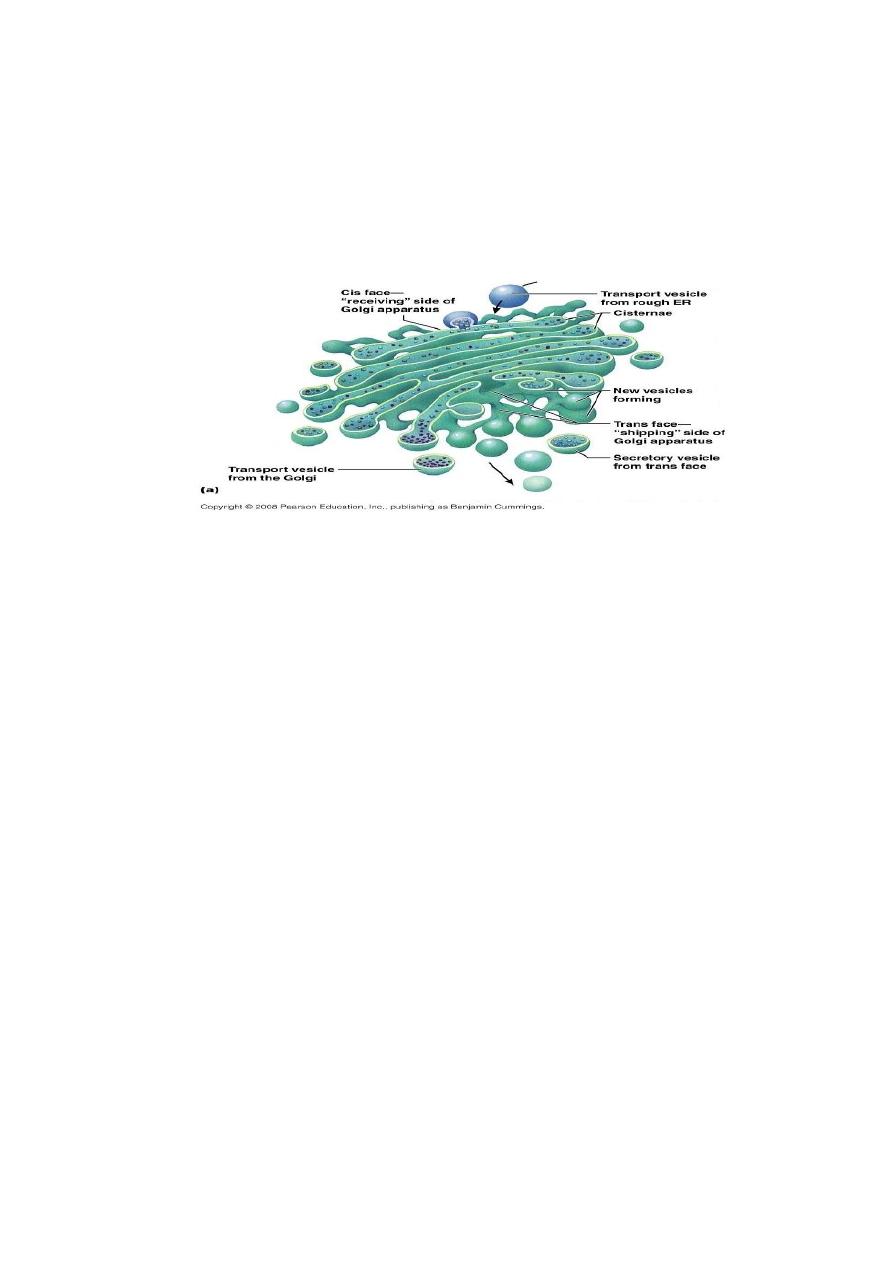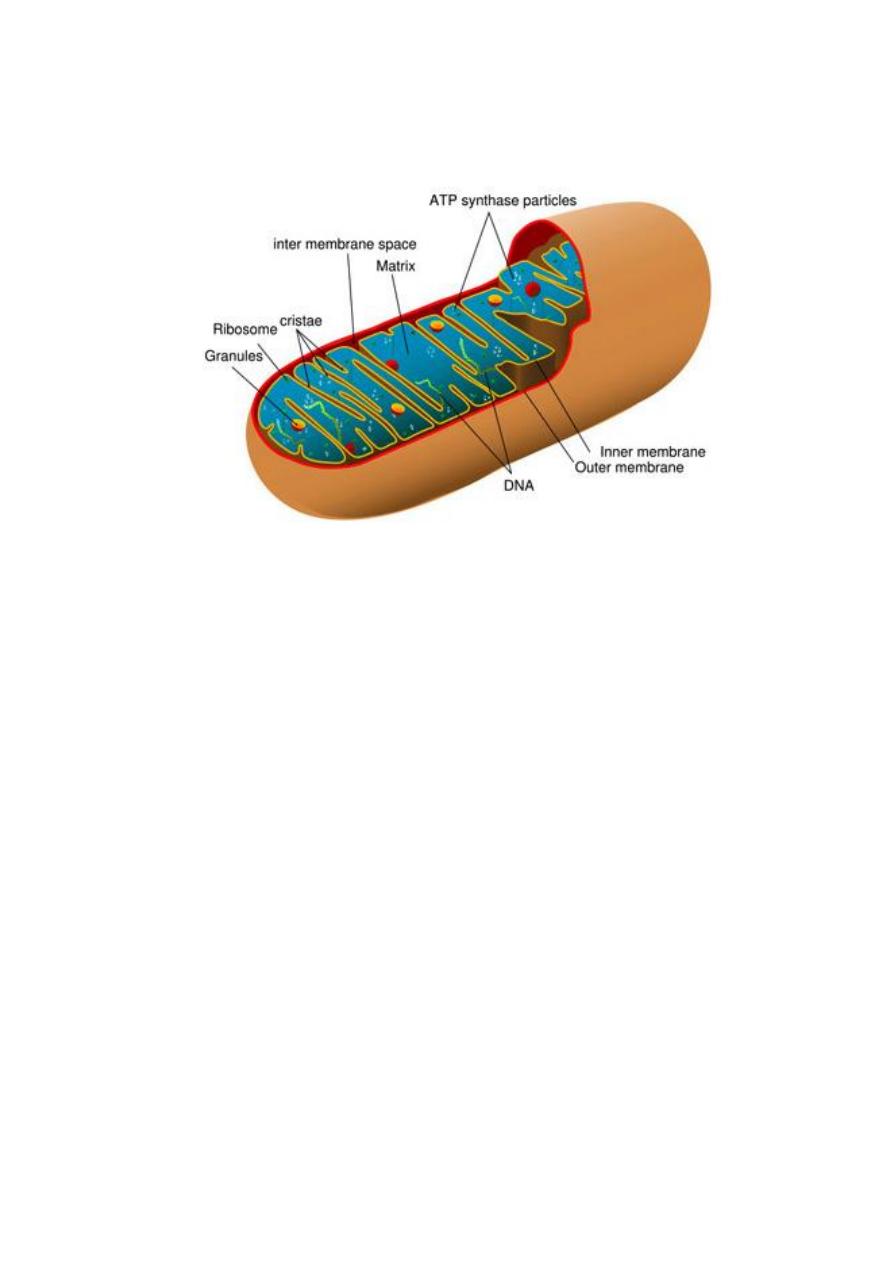
First stage
Biology
Lec-5
14/12/2015
.د
انعام
Structure of the cell
A cell is the basic unit of structure and function in a living thing. When
cells divide, the hereditary information they contain, as DNA, is passed
from cell to cell.
The term protoplasm includes the" living part" of the cell. It can be
differentiated into cytoplasm and the nucleus.
Structure of typical animal cell
The cytoplasm
Cytoplasm is homogenous, clear jelly-like materials that fill the cells.
The cytoplasm consists of cytosol and the cellular organelles except the
nucleus. The cytoplasm plays a mechanical role ,i.e. to maintain the
shape, the consistency of the cell and to provide suspension to the
organelles. In other words cytoplasm is the home of the cytoskeleton, a
network of cytoplasmic filaments that are responsible for the movement
of the cell and give the cell its shape.
(1)

Cellular Organelles
Endoplasmic reticulum
The endoplasmic reticulum (ER) is a network of disk-like tubules,
sacks and vesicles found in eukaryotic cells. Its main function is to
operate as a transport system. It consists of lipid bi-layers which contain
embedded proteins. This system of membrane is continuous with the
double membrane that surrounds the cells' nucleus . The ER is often
makes up more than 10% of cells' total volume. The ER is generally
divided into two major sections: the rough endoplasmic reticulum
(RER) and smooth endoplasmic reticulum (SER). The amount of SER
and RER varies greatly among different cell types.
Rough Endoplasmic Reticulum(RER)
The term rough endoplasmic reticulum is based on the morphologic
appearance of attached ribosomes, which are absent in smooth
endoplasmic reticulum. Another morphologic distinction is the
organization of the rough endoplasmic reticulum is interconnected
flattened sacs ( called cisternae), whereas the smooth endoplasmic
reticulum forms a tubular network. Rough endoplasmic reticulum
branches out and expands as protein synthesis increases, providing more
surface area for ribosome to spread out and create more proteins.
ER works in conjunction with the Golgi apparatus, to target the
newly synthesized proteins to their proper locations. Most proteins
produced by ribosomes of the rough endoplasmic reticulum are destined
for secretion out of the cell. Once a protein is synthesized on a ribosome.
It is enclosed within a vesicle, a small, membrane-bound "bubble". The
vesicles travels to Golgi body. Within the Golgi body, the proteins within
the vesicle are further modified before they are exported from the cell.
Cells that specialized in protein secretion contain large amounts of RER.
For instance, cells of pancreas that produce the protein insulin have
abundant rough endoplasmic reticulum.
(2)

Rough and smooth endoplasmic reticulum
Smooth endoplasmic reticulum
Smooth endoplasmic reticulum has a few different functions in the
cell. And its functions can vary with cell type. SER does not have
ribosomes and is the site of lipid metabolism. They provide surface
area for the action of enzymes and storage space. These enzymes are
used in the synthesis of carbohydrates and lipids.
In liver cells the smooth ER produces enzymes that help to
detoxify certain compounds. For, instance, liver cells remove alcohol
and drugs from the blood stream. In muscles the smooth ER assists in
the contraction of muscle cells. Similarly , cells of the ovaries and
testes, which produce the lipid-containing hormones estrogen and
testosterone, contain large amounts of SER.
Another function of SER is the control the movement of newly
synthesized proteins to their proper location in the cell or to the
membrane to be sent outside the cell. This is done by a process called
budding, where small vesicles of SER are pinched off to carry the
proteins to their new location, various functions of endoplasmic
reticulum makes it an important organelle for maintaining normal cell.
Golgi apparatus
The Golgi apparatus found universally in both plant and animal
cells, it is typically composed of a series of five to eight cup-shaped,
membrane-covered sacs called cisternae that look something like a
stack of deflated balloons.
(3)

The
apparatus
has three primary structures, a Golgi cicternae,
Golgi vesicles and Golgi vacuoles. All the three structures are bound
by a single unit membrane. It is cis face is the side facing the ER,
while the trans face is directed towards the plasma membrane. The cis
and trans faces have different membranous compositions.
Function:
1. Golgi apparatus is responsible for handing the macromolecules
that are required for proper cell functioning. It processes and
packages these macromolecules for use within the cell or for
secretion.
2. Golgi apparatus modifies proteins that it receives from the RER.
3. Transport lipids to vital parts of the cell and creates lysosomes.
4. Some of modifications made inside the Golgi complex include;
attaching polysaccharides to proteins to form gluco-proteins,
cutting proteins into smaller active fragments, incorporating
phosphates on to protein molecules and addition of a sulfate group
to molecules.
5. Other function of Golgi apparatus include the production of
glucosaminoglycans which go on to form parts of connective
tissues.
(4)

Mitochondria
The mitochondria are filamentous or granular cytoplasmic
organelles found in all eukaryotic cells, there distribution in cell
varies. They tend to accumulate in parts of cytoplasm where
metabolic activity is more intense, such as the apical ends of ciliated
cells, around the base of the flagellum or flagella , or at the base of
ion-transferring cells. The cardiac muscle, mitochondria surround the
contractile elements.
The mitochondria have lipoprotein framework which contains many
enzymes and co-enzymes required for energy metabolism and called
power house of the cell.
The mitochondria are bound by double unit membrane. The two
membrane are separated by wide perimitochondrial space or outer
chamber . The outer membrane is smooth, relatively simple phospho-
lipid bilayer, containing protein structure called porins which allows
the passage of molecules up to 10 kilo-Daltons, nutrient molecules,
ATP,ADP and ect., can pass through the outer membrane. The matrix
contains the enzymes that are responsible for the citric acid cycle
reaction.
Mitochondria contain the biochemical machinery involved in
cellular respiration which take energy from breakdown of glucose and
energy-rich ATP molecule which used a source of energy in metabolic
reaction in the rest cell. Hence , mitochondria contain the enzymes
required for the citric acid cycle, ATP synthesis and the oxidation of
fatty acids.
Mitochondria possess genetic material and ribosomes. Mitochondria
DNA is circular and employs characteristic variants of the strand
eukaryotic genetic code.
(5)

Mitochondria
(6)
